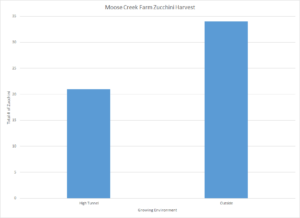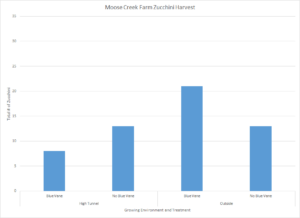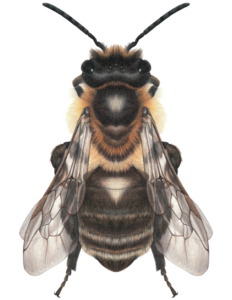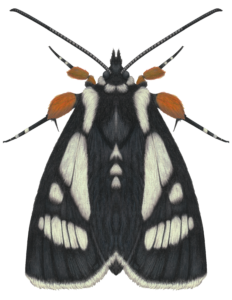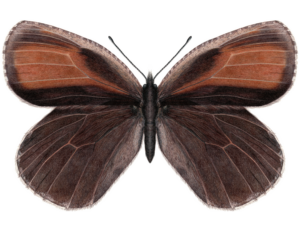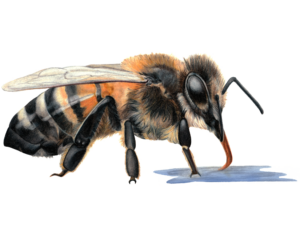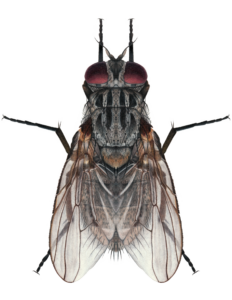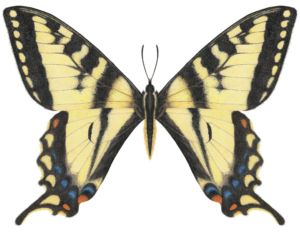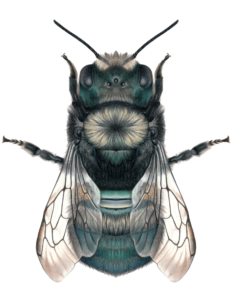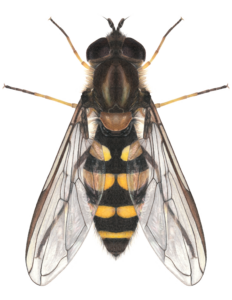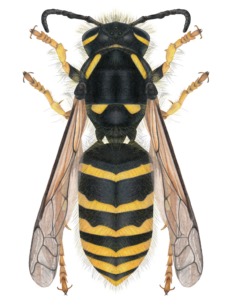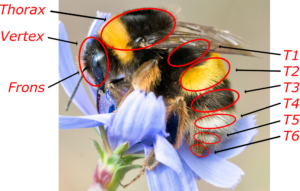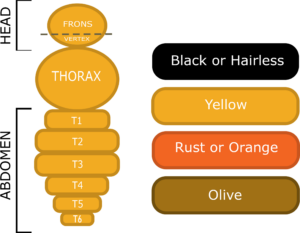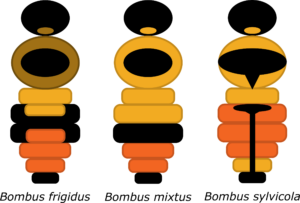Final report for OW18-031
Project Information
Crop pollination is one of the most important aspects of agriculture, both economically and ecologically; however, many pollinators are known to be decreasing worldwide. Anecdotally, many Alaskan farmers have observed similar trends which may affect both pollination and supplemental pollination techniques. It is common to rely on either the importation of commercially-reared pollinators or hand-pollination for successful crop production. This is especially true for greenhouses and high tunnels, as they act as an additional barrier to insect pollination.
With a short growing season, indoor crops are a necessity for Alaskan producers, which can result in the importation of honeybees (Apis melliflera) or bumble bees (Bombus spp.) to supplement pollination. This is of concern because of the possible presence of novel pathogens or parasites which may be transmitted to local native bumble bees. In addition, the cost of bee packages has soared due to the destructive presence of the Varroa mite (Varroa spp.), colony collapse disorder, and the great shipping distance to Alaska. Hand pollination is an alternative to purchasing pollinators, but this is a time-consuming and tedious process for farmers.
Blue vane traps are tools that entomological researchers use to attract and study pollinators. Their success at attracting bees in particular raises the question if they could be utilized to attract insects for agricultural purposes. Zucchini (Cucurbita pepo) and tomatoes (Solanum spp.) are warm-season plants that exhibit high variability in pollination success and benefit from supplemental pollination techniques. In Alaska, many zucchini and tomatoes are grown in high tunnels to extend the growing season and increase temperatures. The high tunnel environment does aid heat capture but it may also inhibit insect travel further complicating pollination success. While there are several other factors that influence pollination such as nutrient availability and weather, this study seeks to understand one aspect of pollination – attracting pollinators, and if growing certain crops such as zucchini and tomatoes in a high tunnel affects their pollination.
Our multi-year study assessed whether modified blue vane traps could be used to attract pollinators to increase pollination success in high tunnels. We worked with farmer producers to implement on-farm research for increasing pollination of tomatoes and zucchini and conducted a paired comparison study for increasing pollination of tomatoes. We found no significant differences in pollination success between plants that used modified blue vane traps to attract pollinators and control plants. It’s possible that these traps may truly have no effect on pollination but it is also possible that we had too small of a sample size to detect any differences – or even that the techniques we used with the traps were not the best ones. While there were no significant findings, this study has reinforced the concept that farmers still need simple and effective ways to increase pollination in their greenhouse and high tunnel structures.
To meet educational objectives, we provided on-farm consultations about native pollinators and their habitats, conducted a survey of producer pollinator habits and knowledge, and wrote articles for newsletters. We spoke with students and children about pollinator identification. Lastly, we developed detailed and engaging educational materials about native pollinators, their habitats, and the critical roles they play in crop pollination. We presented this educational material at outreach events throughout Interior Alaska and installed a permanent exhibit at the Georgeson Botanical Garden on the University of Alaska Fairbanks campus in Fairbanks, Alaska.
1. Assess a simple method of attracting native pollinators to high tunnels with modified blue vane traps to enhance pollination success.
a. Evaluate in a paired comparison experiment whether native pollinators are drawn and attracted into high tunnels by comparing small high tunnels with and without modified blue vane traps near their entrance. Monitor and quantify pollination success through the successful production of tomato fruit at the Georgeson Botanical Garden with the use of four small greenhouses in 2019-2020.
b. Conduct producer farm trials and work with farmers to evaluate pollination success differences between tomatoes and zucchini with and without blue vane traps within high tunnels in 2020-2021. Monitor the effect of modified blue vane traps under different growing conditions on zucchini harvest in 2021.
2. To engage local partners, farmers, and the public in discussions related to the importance of pollinators to agriculture and factors affecting pollinator health.
a. Outreach events throughout interior Alaska including the Tanana Valley State Fair, Alaska Pollinator Week at the Georgeson Botanical Garden, Interior Alaska Home Show, the annual meeting of the Alaska Farm Bureau, and one national event – the Great Lakes Expo and Conference.
b. Design and create engaging educational material in collaboration with entomologist and artist Renee Nowicki that highlights Alaska pollinators. Create an interpretive exhibit at the Georgeson Botanical Garden to permanently install interpretive signs of the Alaska pollinator artwork in the habitats which those pollinators reside.
Cooperators
Research
2018: Materials and supplies were purchased over the winter of 2018 for use in starting both on-farm demonstrations and the paired comparison experiment at University of Alaska Fairbanks (UAF). Due to wetter than normal climatic conditions in the summer of 2018, we began this experiment in summer 2019 with farmer field trials starting in 2020.
2019: We set-up two pairs of small high tunnels (four total) for a paired comparison trial at the Georgeson Botanical Garden on the UAF Campus. The dimensions of the high tunnels were all equal at 6' x 8' x 6.5' in size. A treatment high tunnel (blue vane traps hanging from the entrance) and a control (no blue vane traps hanging from the entrance) served as a study comparison pair and were placed approximately 30 feet apart. A duplicate of this pair was placed approximately 200 feet away, to control for any pollination differences between location. This could occur if there were different plant community assemblages that brought in various levels of pollinators. These pairs were titled, ‘West’ and ‘East’. Within the high tunnel, six tomato plants of the ‘Stupice’ variety were planted in five gallon growing containers and fertilizer amendments were standardized among all the treatments. Plants were watered regularly with drip irrigation.
In this paired comparison trial, we measured tomato yield (weight), girth, and filled seed percentage throughout the growing season. We considered ‘filled seed percentage’ the percentage of seeds within an individual tomato that was successfully pollinated. Pollinated seeds are full and plump, while seeds that were not pollinated are very small and shriveled. Our ‘filled seed percentage’ does not distinguish pollination success from insects, wind, or self-pollination. We called the difference between filled and unfilled seeds, the pollination success rate.
2019: We conducted a pollinator survey to better understand pollination practices for producer farmers. We asked questions regarding importing honey- and bumblebees, hand pollination, management practices that encourage pollinators, and insects observed.
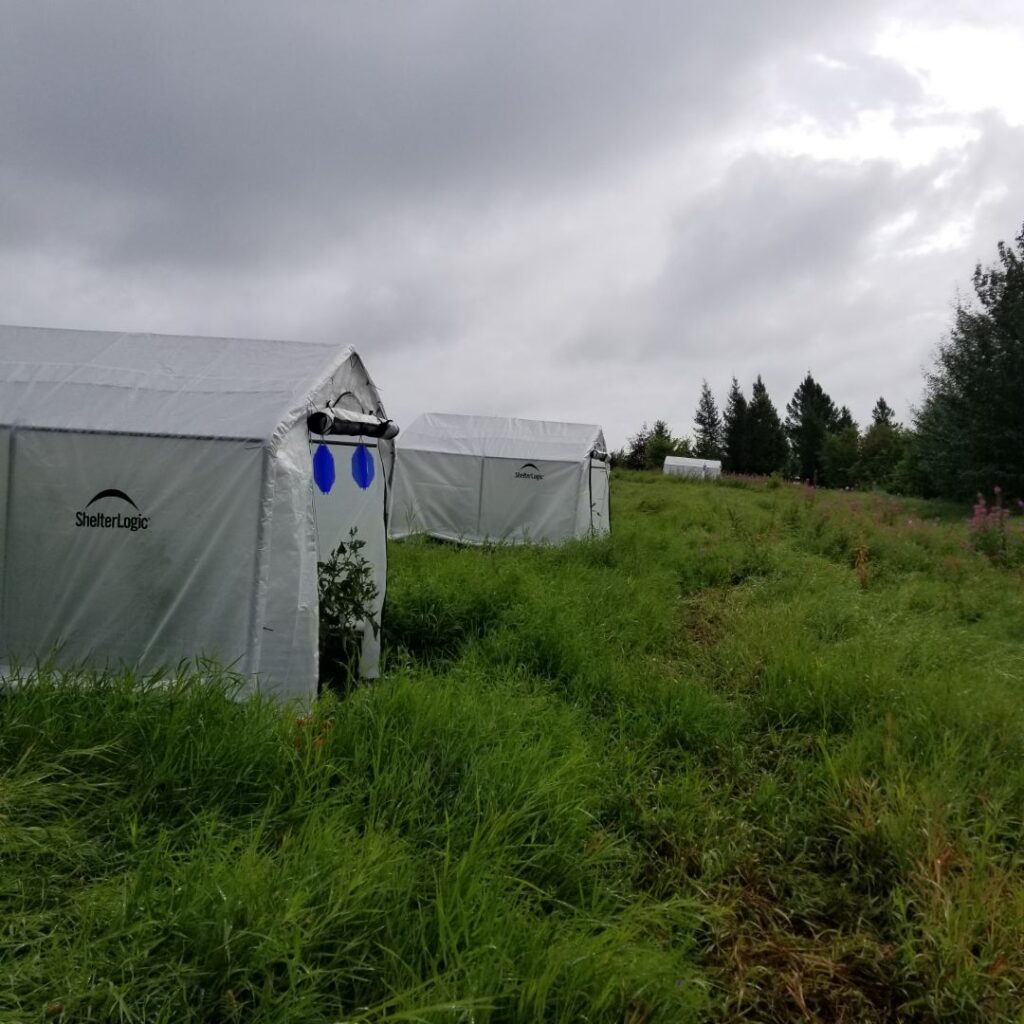
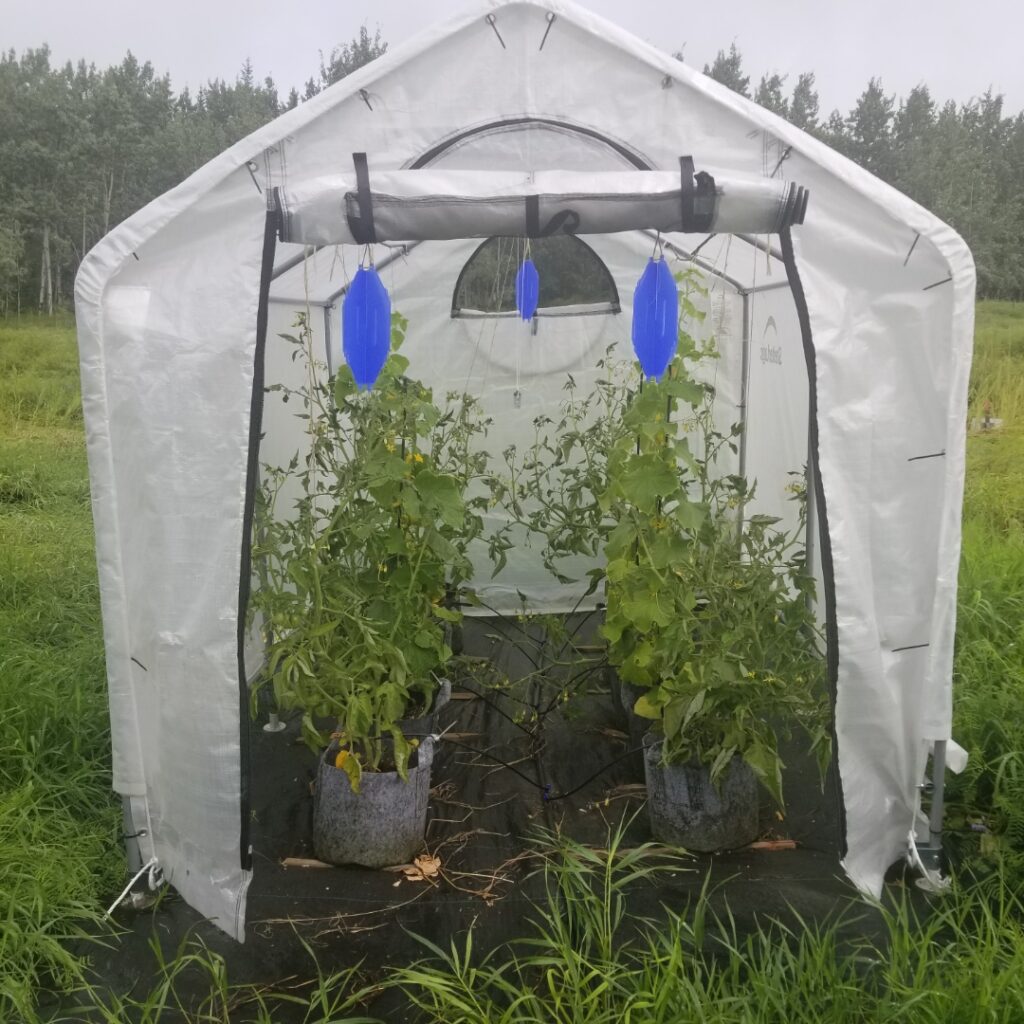
2020: We completed year two of the paired comparison trial of the mini high tunnels again at the Georgeson Botanical Garden on the UAF Campus. We measured the same variables as we did in 2019, with the exception of a different tomato variety (Early Girl), and a higher number of blue vane traps as attractants around the entrance to the mini-high tunnels.
In 2020, we also collaborated with three farms for on-farm research trials. Moose Creek Farm and Frosty Acres Farmstead participated by placing modified blue vane traps directly on tomato plants, with a treatment and control replicated twice within a high tunnel. They weighed, counted, and recorded tomato metrics weekly, or as they were harvested. Spinach Creek farm participated by hanging modified blue vane traps throughout the center of a field of zucchini, to see if this would attract early season pollinators to increase pollination success. Data was not collected but anecdotal observations were recorded.
2021: We placed four blue vane attractant treatments at Moose Creek Farm that were active from June 21 to September 7 for a total of eight zucchini plants in the study. Two treatments and two controls were outside of a high tunnel while two treatments and two controls were inside a high tunnel. The zucchini plants were seeded on April 20, transplanted on May 30, and were watered through drip irrigation. The variety planted was Black Beauty, an early heirloom variety with a bush-like growth habit commonly grown in interior Alaska.
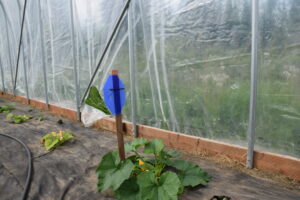
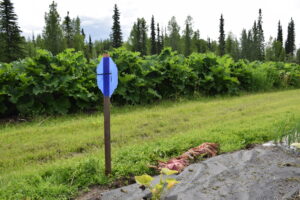
Results:
2019: In the pollination survey, we had nineteen farmer producer participants. Fourteen producers actively engaged in hand-pollination and zero imported honey- or bumble bees specifically for pollination. Thirteen producers regularly encourage pollinator activity by allowing selected crops to flower, planting cultivated and wild flowers, allowing natural habitats to flourish, or planting perennial berry bushes. Farmer producers were able to identify many insect guilds such as bees (honeybee and bumblebee), butterflies, moths, mosquitos, ants, dragonflies, aphids, ladybugs, thrips, Lygus bugs, spiders, hornets, stinkbugs, wasps, worms, and flower flies.
2019-2020: In the paired-comparison tomato trial, we found no differences in tomato yield between high tunnels with attractant treatments and control groups (Figure 1). We also compared tomato yield by location to examine if there were any differences in pollination between the treatments, which there were none (Figure 1). Using filled seeds as a proxy for pollination success, we compared the percentage of filled seeds between treatments and location and found no differences (Figure 2). Looking at the relationship between weight and girth in tomatoes to understand if differences in pollination could affect harvest yields, we found no differences among treatments or locations (Figure 3). We successfully repeated the paired-comparison tomato trials in 2020. Our results were similar to 2019, with no statistically significantly results between control, treatment, or location effects.
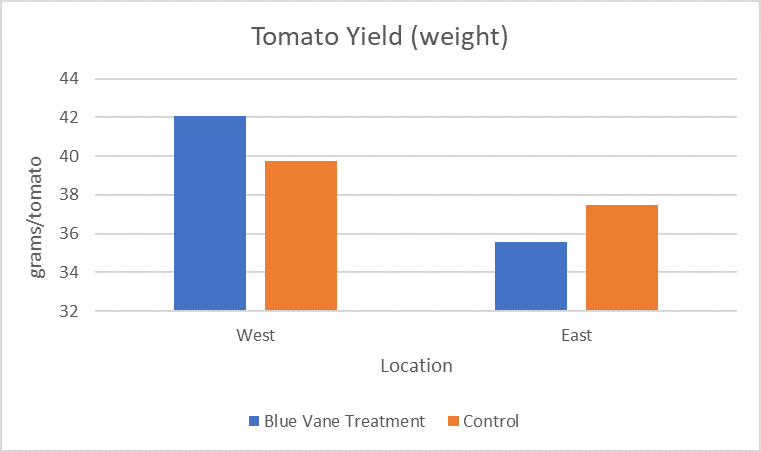
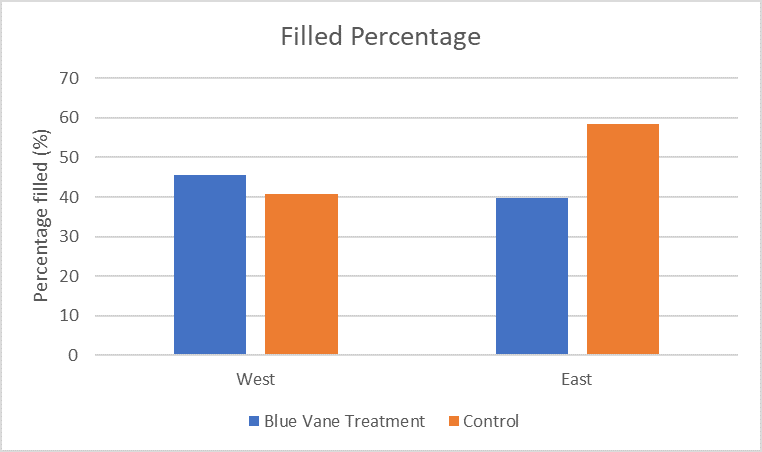
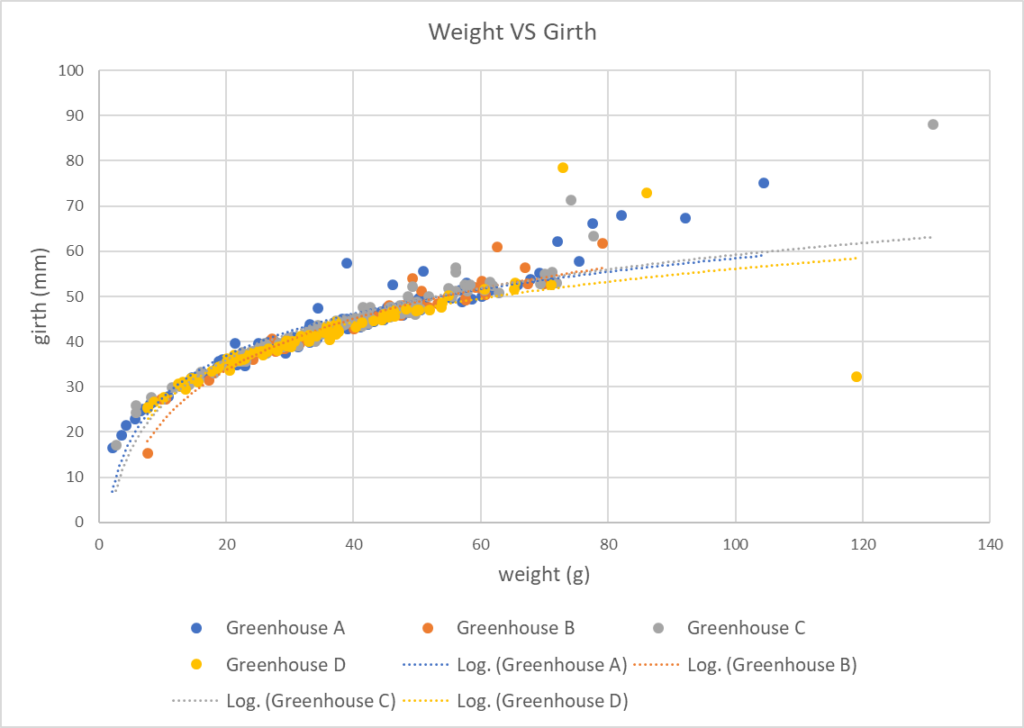
2021: For our zucchini experiment, Moose Creek Farm began harvesting zucchinis on July 6 and continued through September 7. There were a total of 55 zucchini harvested from the eight plants over this time period. In comparing the number of zucchini harvested by treatment: there were 29 zucchini harvested from plants with blue vane attractants and 26 zucchini harvested from control plants (see Figure 4). In comparing the number of zucchini harvested by growing environment, there were 34 zucchini harvested from outside and 21 zucchini harvested from inside the high tunnel (see Figure 5). If we were to break down the number of zucchini harvested outside into treatment and non-treatment categories then the greatest number of zucchini harvested were from plants that were outside with blue vane attractants (see Figure 6). There was no difference at all between control plants inside or outside of high-tunnels (see Figure 6).
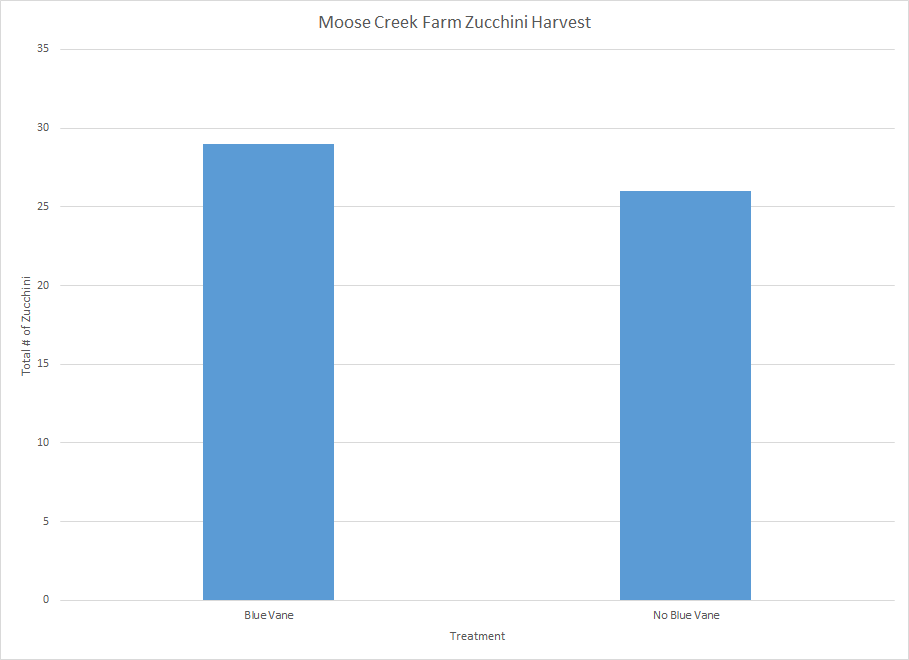 Figure 4. Moose Creek Farm zucchini harvest with blue vane attractants as a treatment and no blue vane attractants as a control from July 6 to September 7, 2021.
Figure 4. Moose Creek Farm zucchini harvest with blue vane attractants as a treatment and no blue vane attractants as a control from July 6 to September 7, 2021.
Figure 5. Moose Creek Farm zucchini harvest under different growing conditions – inside a high tunnel and outside of a high tunnel from July 6 to September 7, 2021.
Figure 6. Moose Creek Farm zucchini harvest under different growing conditions (high tunnel, outside) with blue vane attractants as a treatment and no blue vane attractants as a control from July 6 to September 7, 2021.
Discussion:
2019 Pollination Survey: Results from our pollination survey show that farmers are aware of the importance of pollinators and actively try to encourage them. We also learned that importing bees specifically for pollination was not occurring at the scale we anticipated. This does not mean that there is not significant importation of bees only that the primary reason is not crop pollination. While we did not explore this primary reason, it is most likely for honey production.
Our survey and conversations with farmers also showed that many were able to identify genera of insects that affect agriculture either as pollinators or pests. We propose that more specific identification of insects and their habitats could benefit farmers. For example, we placed interpretive signs of pollinators in their appropriate habitat at a botanical garden; for example, a flower fly (Parasyrphus tarsatus) in an onion and chive patch (Allium spp.). Matching pollinators to specific plants on farms in subarctic Alaska would be a good area for future research. Understanding which plants attract which insects would allow local farmers to target the particular insects they want to aid their agriculture and refine their efforts.
2019-2020 Paired Comparison Study of Tomato Pollination: Greenhouses and high-tunnels are necessary for successful tomato production in Alaska. While they don’t significantly lengthen Alaska’s short growing season they do increase the ambient growing temperatures that allow warmer zone plants to flourish. This hot-house infrastructure does have the trade-off of reduced crop pollination. Our study sought to investigate easy-to-implement techniques to increase pollination success for farmers growing tomatoes in interior Alaska.
We did not find significant results in the paired-comparison experiment using mini high tunnels or in the farm trials. There were slight trends to the data but no statistically significant results. This might be due to the small scale and sample size of the study. It may have also been influenced by the number and placement of the blue vanes which were meant to attract pollinators into the high tunnel.
Despite not having significant results, we still believe that the idea of using attractants to increase pollination is valid because of anecdotal observations that the farmers supplied such as increased traffic of bumblebees. In addition, our pollination survey confirmed that farmers are using time-intensive hand pollination frequently. Techniques that are extremely low in cost and maintenance suggest a tool that lends itself well to experimentation.
We propose that we may not have discovered the best configuration, type of attractant, or that the attractants may have had more indirect effects that we weren’t measuring such as earlier harvests or increased maturity of fruit at termination. Alaskans have difficulty ripening tomatoes because of the short-growing season. Techniques that affect the timing of pollination could result in tomatoes that ripen earlier in the summer increasing the potential of successive harvests.
2021 Zucchini Experiment: High tunnels in Alaska are commonly thought to increase the productivity of garden plants though higher temperatures and a longer growing season. The Moose Creek Farm observations are contrary to this paradigm because less zucchini were harvested from inside the high tunnel. There could be several reasons why this occurred including different high tunnel cultural practices but the most likely reason is that high tunnel coverings negatively impact insect pollination.
We did not see any indication that blue vane traps increased harvest in the high tunnel, which was our initial objective. This could be because there were not really any pollinators in the high tunnel or again, our lack of data. It’s also possible that the type of attractant could influence levels of pollination under different growing conditions. For example, an artificial attractant such as the blue vane trap only provides ultraviolet visibility cues which may not be enough for the high tunnel environment. However, a natural attractant such as a blue flower could provide visibility, scent, and a subtle electromagnetic field – all of which pollinators such as bees use to find and pollinate flowers.
We did not have the number of producers we originally anticipated for the zucchini experiment and others due to the Covid-19 pandemic; therefore, we are providing a description of the data that does not amount to a statistical test. As a result, the zucchini data should be used as an observation that could lead to greater exploration or hypotheses on the topic. The primary observation revealed by our investigation is that there were a greater number of zucchini harvested in an outdoor growing environment when an attractant was present. We suggest using this observation to guide a future study on the full comparison of indoor vs. outdoor harvest of zucchini and to examine the effects of different types of attractants on increasing pollination success under varying growing conditions. This observation has also shown that a high tunnel doesn’t necessarily increase the productivity of all plants growing within. To optimize harvest, careful consideration should be given to the placement of plants within high tunnels that rely heavily on insect pollination as well as the cultural practices that increase pollination success.
Research Outcomes
Education and Outreach
Participation Summary:
2019: We collaborated with several farmers and UAF faculty in preparation for the 2019 field season. FSWCD discussed the upcoming project and importance of pollinators at several outreach events including the Tanana Valley State Fair, the Alaska SARE Conference, and at the Great Lakes Expo and Conference in Grand Rapids, Michigan.
During 2019, the following outreach and education activities were completed:
- A pollinator survey was conducted with 19 Interior Alaska farm respondents
- Educational activities to 400+ elementary students at Fort Wainwright Earth Day celebration
- Outreach activities including a farm pollinator habitat diorama and informational booth at the Tanana Valley State Fair
- Presentation to University of Alaska Fairbanks Natural Resource Management undergraduate students about pollinators
- On-farm consultations (3) about pollinators and their role in farm productivity within high tunnels
- University of Alaska Fairbanks community garden pollinator habitat flower beds
- Newsletter to all FSWCD cooperators
- Social media posts to FSWCD Instagram and Facebook
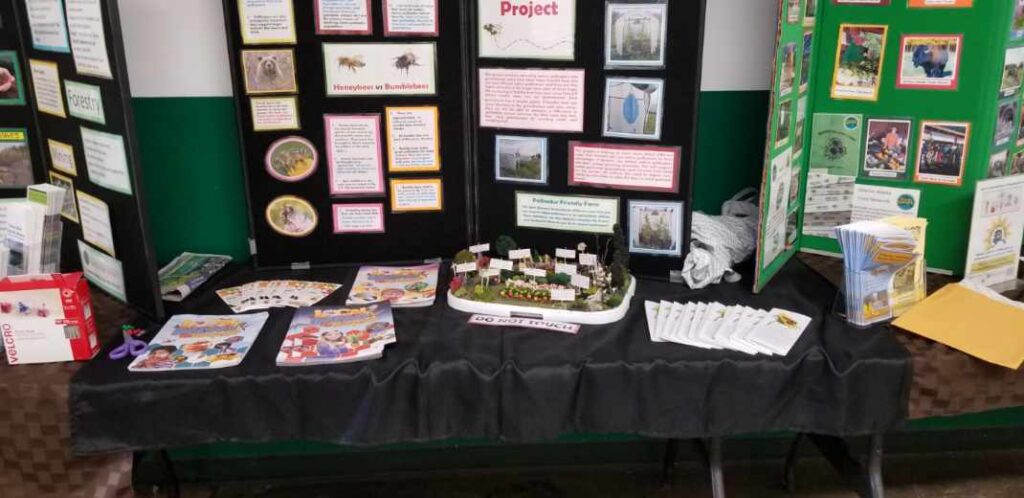
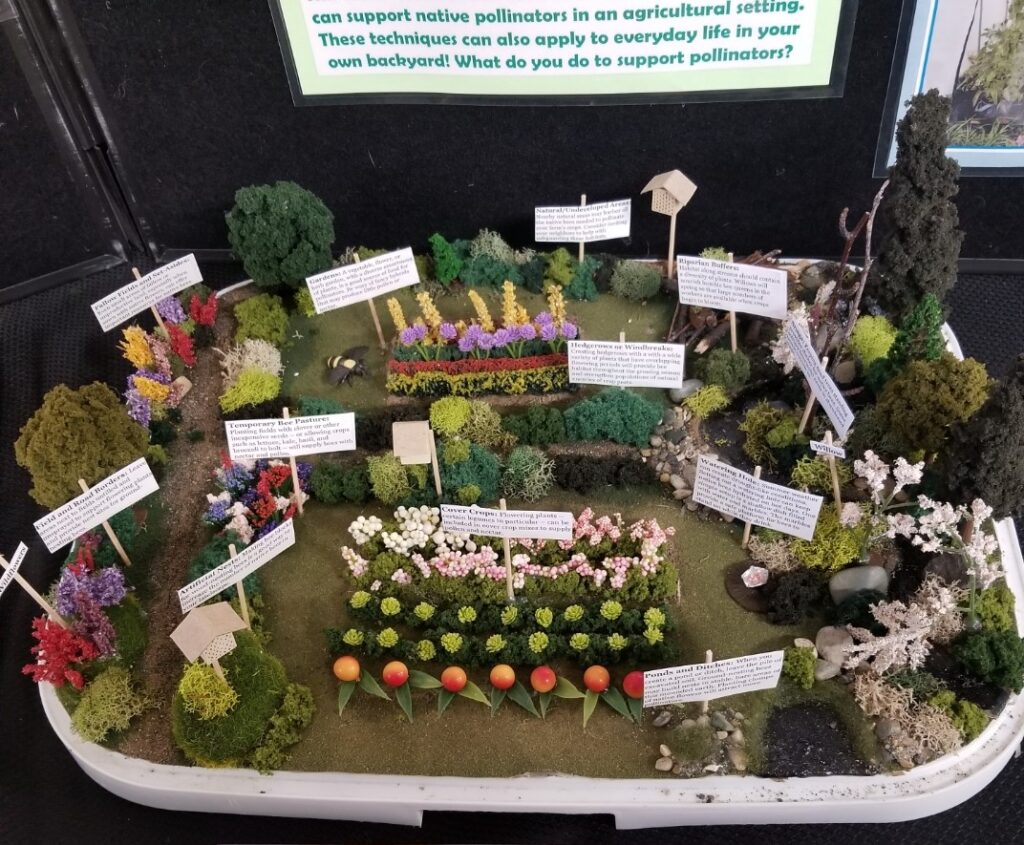
2020: Overall, educational and outreach activities were greatly limited due to the Covid-19 pandemic. We had 3 additional on-farm consultations about native pollinators and pollinator habitat in 2020.
We began a collaboration with the Georgeson Botanical Garden to create an interactive "scavenger hunt" for native pollinators in Interior Alaska. This interactive activity consists of custom-made artwork and signs by our entomology specialist and artist Renee Nowicki. Interpretive signage will be located throughout the botanical garden for both adults and children to learn about identification, habitat, behavior and ecological importance of local pollinators. We continued to work on this garden activity throughout 2020 and 2021.
2021: During 2021, we completed the pollinator artwork consisting of detailed colored pencil drawings of pollinator species commonly found in interior Alaska. There were nine total illustrations of the following species: Solitary Mining Bee (Andrena scotia), Macculloch's Forester (Androloma maccullochii), Red-disked Alpine (Erebia discoidalis), European Honey Bee (Apis melliflera), Common House Fly (Muscina stabulans), Canadian Tiger Swallowtail (Papilio canadensis), Mason Bee (Osmia spp.), Flower Fly (Parasyrphus tarsatus), and Alaska Yellowjacket (Vespula alascensis).
During 2021: We also created graphics to identify bumble bee species. These three graphics are used in concert to aid in identification of bumblebees common in interior Alaska.
During early summer 2021, we developed a "Pollinators of the Georgeson Botanical Garden" brochure to introduce visitors of the botanical garden to native pollinators in interior Alaska. This brochure consists of the detailed entomological illustrations and descriptions that our entomological assistant and artist, Renee Nowicki, created as education materials for this project. It also contains a scavenger hunt to find pollinators within the garden and a QR Code for monitoring Alaska's pollinators with iNaturalist through a project called the Great Alaska Pollinator Challenge. We set up this project on iNaturalist (https://www.inaturalist.org/projects/the-great-alaska-pollinator-challenge) to invite garden visitors and other folks across Alaska to learn about native pollinators. This citizen-science project ran from June 1, 2021 to August 31, 2021 garnering 26,826 observations with 2,179 species and 1,172 observers. Also in early summer, we displayed ten temporary interpretive signs we created for the project using the illustrations along with this brochure for Alaska Pollinator Week, June 21-27, 2021, at the Georgeson Botanical Garden.
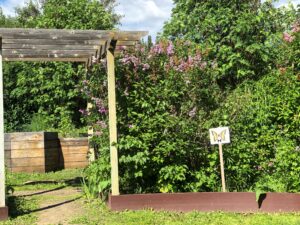
In mid-summer, from July 30-August 8, 2021, we displayed these illustrations as posters in the Farm and Garden as well as the Small Livestock exhibits at the Tanana Valley State Fair.
In July, we planted native plant and pollinator habitat in the downtown community of Fairbanks along the banks of the Chena River. This planting included perennial silverberry (Elaeagnus commutata) and red-osier dogwood (Cornus sericea) both of which are early flowering and provide food for pollinators at a critical time. These plants are multi-purpose and help to stabilize riparian areas.
At the end of the summer on September 30, 2021, we completed installation of ten permanent pollinator garden signs throughout the Georgeson Botanical Garden. These signs were illustrated and designed by Renee Nowicki and included both the pollinator drawings and life history descriptions of the native pollinators that could be found in the botanical garden.
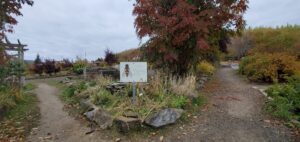
Lastly, we were invited by Western SARE to help create an informational flier to display at the Annual Alaska Farm Bureau Convention and Tradeshow which was hosted in partnership with Western SARE. This flier was created by Steve Elliott with University of California College of Agriculture and Natural Resources and was displayed and distributed at the convention from November 12-14, 2021 in Anchorage, Alaska.
The educational materials we created for this project will have a far greater reach than just the project timeline. We plan to go beyond the deliverables we listed and share the illustrations with local interior Alaska farms, science camps, and school groups to continue to raise awareness about local pollinators. We also plan to develop a pollinator page for our organizational website that highlights the illustrations and the citizen-science project we started on iNaturalist. Looking ahead, we have created scientific art that will continue to serve multiple purposes and inspire those who view it to learn more about pollinators.
